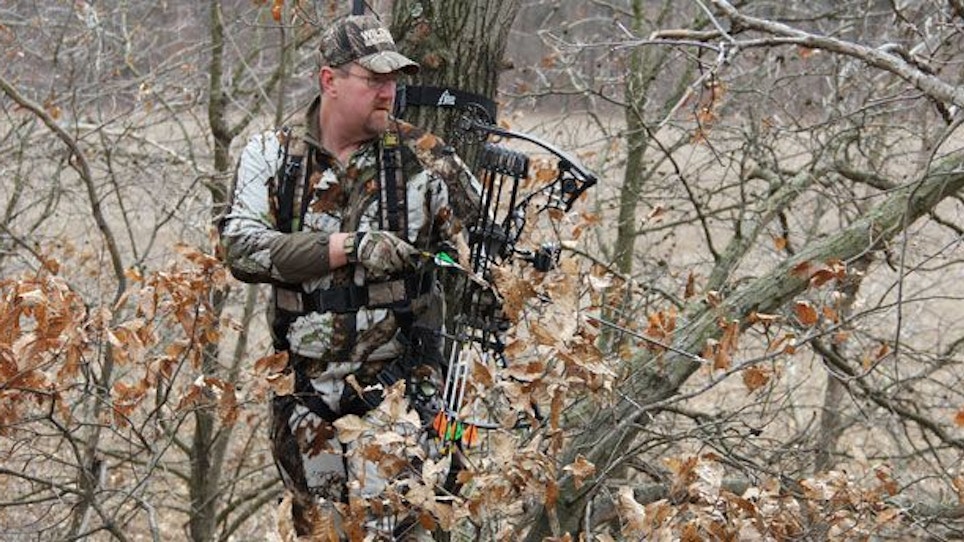One glance at the sea of tracks littering the snow revealed this was where I needed to setup. With the cornfield sitting more than 100 yards from the wood edge, and trails leading to the food resembling spokes on a wheel, a ground blind in the corn would be my best bet.
Luckily, the hottest area of activity in the picked portion was adjacent to the area Fair Chase Outfitter’s owner, John Redmond, had left standing for the deer. With ample harvest waste still on the ground, the deer were still feasting on the easier pickings.
After removing the odor-free blind from the garbage bags sealing it, I selected a location five yards into the standing corn and cleared what would become the blind’s footprint. Then there were the mundane tasks of positioning the chair, properly orienting the bow holder and meticulously adjusting the window openings. Finally, a corn stalk weave blended the exterior of the blind.
Sure, many of the tasks were dull, but the excitement of that afternoon’s hunt more than made up for it. Each of those little stand details had been critical in allowing me to enjoy a thrilling Minnesota late season hunt.
Breaking Down a Blind Hunt
With each year, I become more struck by how critical the little things we address and ignore factor into the outcome of hunts. In fact, for every time one gets ”lucky”, one can point to 10 or more situations where even failing to address one little detail would have or did come at a high cost.
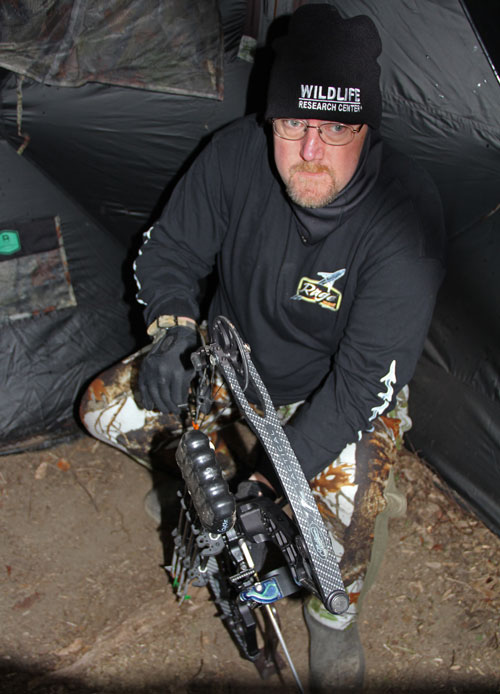
Staying undetected in a blind also includes hiding the blind. The corn stalk weave certainly helped, but my actions the year before were at least as important. With a can of white spray paint, I gave the blind snow camo face lift. Because of that, it blended far better in the snow covered cornfield than its fall camo allowed.
Next came the decision to wear black gloves, hood and top inside the blind, as well as spending what would seem to be way too much time adjusting the window opening. By doing so, I faded into the dark shadows inside the blind.
My vanishing act paid off many times that afternoon. I stopped counting deer at 20 that sit, and most were right in my grill. The fact that a couple does brushed the blind illustrates that.
Still, it was the 2.5 year old 10 point that created the greatest challenge.
Adrenaline Pumping
Emerging about an hour before dark, outside of admiring what he would grow into, I initially gave him little thought. That changed when he eventually fed his way too directly in front of the blind. Hovering around five yards out, he spent more than 30 minutes in my lap. I can’t adequately describe the thrill of having a deer that close, looking through you, yet never having a clue anything is amiss. Of course, minimizing movements also played a role. Sure, it’s more comfortable sitting facing deer. Turning one’s head for hours can be a pain.
Unfortunately, sitting head-on necessitates shifting 90 degrees to shoot. When on ground level, that can be impossible to pull off. Positioning the chair at 90 degrees may strain one’s neck, but it also greatly minimizes the movements required to shoot.
Another big help is having the bow holder positioned just off a right handed shooter’s left knee, orienting the bow to point towards the likely shot location. It’s easy to think laying the bow on the ground or across one’s lap is harmless, but consider all that extra movement. Bow hooks hanging from the hook of blinds can be even worse, as removing the bow causes the roof to move.
With proper orientation, you can slowly drop the left hand a few inches to grasp the bow, while shifting the right a few more to attach the release. After that, raise the bow and come to full draw in one natural motion. Considering the sea of deer eyes within 60 yards, including the 2.5-year-old buck in my lap, minimizing motion would be critical.
Minimizing noise was also critical. Shifting in a chair seems harmless, but try it on ground level during late season in front of deer. Do so once and you’ll gladly trade having to turn your head for proper chair orientation.
Another noise minimizer was meticulously clearing the blind’s footprint of any debris. Doing so allows for minor shifts in foot positioning. That may seem trivial until one is forced to sit otherwise motionless for close to an hour.
The final noise minimizer was wearing an all black Heater Body Suit. This was late December in Minnesota. The bitter cold temps increased the odds of the deer hitting the food early. In fact, they began arriving 3 hours before dark. Sitting motionless for hours is tough in very cold temps, but the Heater Body Suit delivered on its promise to keep me comfortable the entire time. Until I came out of the suit to shoot, I’d forgotten the temps were around 0.
T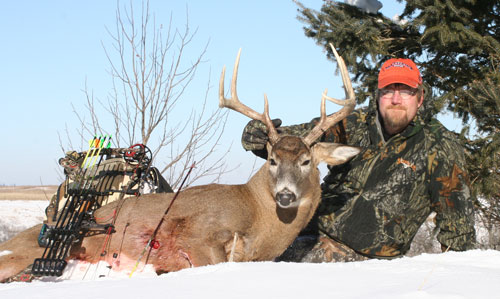
Right at sunset, I spotted the old 8 point at the edge of the woods. With deer feeding all around me, it didn’t take him long to feel assured that the coast was clear. Knowing instantly he was a shooter, my immediate concern was making this happen.
Before long, the old 8 had bridged the CRP and settled into feeding mode. I mentally judged him at about 50 yards. Broadside and stationary, I believed I could make the shot, but needed to be 100% certain on the distance. For shots this long, everything had to be perfect.
With the young buck still looking through me as he fed, I timed raising the range finder to when he dropped his head. Putting the old 8 at 52 yards, I again waited for the youngster to scavenge. In one slow, smooth motion I grasped and drew my bow. Reminding myself to slow motion the event, I placed my 50 yard pin on the top of his heart. If he didn’t react, my arrow should center punch it. If he dropped, it would be a double lunger.
Squeezing off the shot, I knew immediately it would be true. There was no drop. That is, until the Rage Titanium tipped Easton blew through his heart and literally shattered his opposite side leg. Regaining himself, the buck twirled and tore off. Just out of sight, during his 60 yard dash, he crumpled into a ball. Every one of those seemingly little details turned out to be critical in filling that buck tag.
Making Trees Work
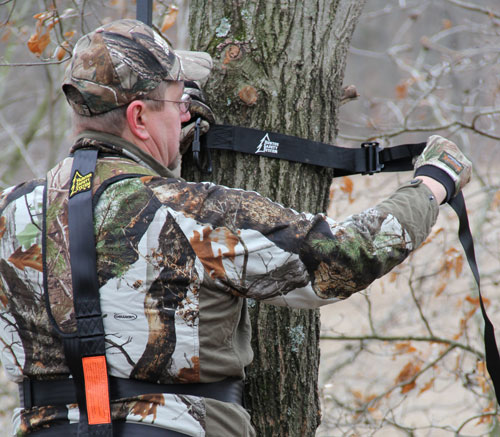
Tasked with managing a 1,550-acre farm, I quickly discovered that I had three serious challenges: an over-population of deer, a significant lack of nutrition and several fully mature, dominant bully bucks that needed to die. I liked that last challenge.
One buck in particular needed to meet my arrow. The 6.5-year-old I named G2s was a brute of an 8 scoring just over 134 inches. He was everywhere within a 500-acre portion of the farm. In just two months, I’d gotten more than 300 scouting pictures of this bully. Between his maturity, a rack made for fighting and a nasty disposition, I set him as my top priority.
From the scouting pictures, I was able to determine where G2s bedded. From the ridge point, he would either first hit the skinny clover field or work the ridge down to the corn. Either way, he would consistently make the corn during legal shooting hours. I was confident that was where I could kill him.
The issue was that there wasn’t a great tree. Where I needed to setup, the best positioned tree was a little oak, just five yards in from the field edge. From it, I could cover the pinch in the standing corn G2s traveled from the skinny clover, as well as the old ATV trail dropping down the point.
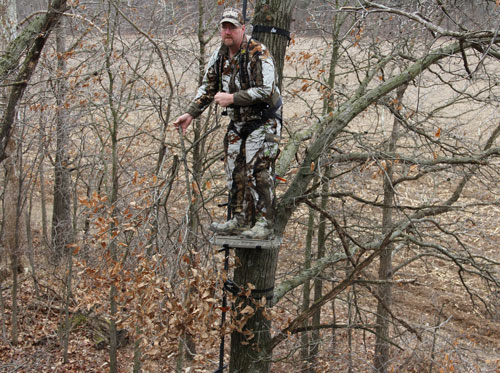
The next step was adding cover. As is, the tree still left me silhouetted to the ATV trail deer. However, cutting and weaving a few branches into the outer edge of the stand platform gave me all the cover I’d need.
Because the buck bedded above me, I’d also have to be worried about extra movement after climbing into the tree to hunt. The simple step of buying extra safety harness tree straps allows me to leave one attached and ready. With that, I eliminate the noise, time and movement of attaching the tree strap when hunting.
My last step towards going unseen was creating a mock scrape on the opposite side of the ATV trail from the stand. Even with extra cover, drawing undetected could be an issue. With the tree size not allowing me to go over 14 feet up, I needed a distraction. The mock scrape would do the job.
The plan was simple. With the mock scrape positioned in my shooting lane, 15 yards from the stand, the buck would stop and check it before entering the field. Being on the opposite side of the trail, his attentions would be pulled away from me, providing an easy quartering away shot.
Lastly, with G2s bedding right above me, getting in would be tricky. I was confident that I could go unseen, so long as I went unheard. The dry creek bed would provide a low profile, but crunchy leaves threatened to give me away.
The first available nasty day, I grabbed a rake and headed for the stand. The rain sapped the crunch from the leaves, while the high winds created cover noise. Also, between taking odor control steps and the rain washing away unwanted odors, no tattletale scent of my activities would betray me.
It was under those conditions that I raked a trail down the dry creek bed and up the bank to my stand. With that, so long as I stayed low and went slow, I could slip in undetected.
A couple afternoons later found me slipping up the creek for my first crack at G2s. Settling into the stand, I was confident I’d gone undetected.
It was a slow sit, not seeing the first deer until right after sunset. As the doe and her fawn fed behind the stand, I began doubting I’d meet G2s today. Those doubts didn’t last long.
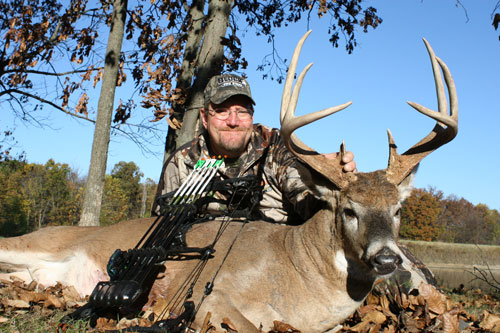
After what seemed like a lifetime, he finished off the scrape and resumed his trek down the ATV trail.
As he hit the creek, I knew this would be a challenge. Despite the steps I’d taken, the doe presented extra issues. Still, if I waited for him to work the mock scrape, his angle should take her eyes off me just enough to carefully come to full draw. Luckily, I always hold my bow in tree stands to minimize movement and maximize fleeting opportunities.
Paying no attention to the doe, G2s sniffed the scrape and raised his head to work the licking branch. As he did, I slowly came to full draw, silently praying the doe’s gaze was fixated on him. Not hearing a snort, I placed the pin and sent the arrow home. Despite being pinned down by the doe, controlling as many little details as I could allowed me to remove the biggest bully on the farm!
Conclusion
Unfortunately, it would take an entire book to address all the stand related details that can turn a close encounter into a kill. Luckily, they all start by asking a simple question. What can I do to make this stand better and minimize its liabilities?
In some cases, that may be to improve the creek crossing your stand covers, while blocking another that the deer also use. On a field, young clear cut or any other open draw larger than one’s bow range, maybe it’s planting a scrape tree 20 yards out in the opening. That simple step can draw bucks in from out of range. Yet another example may be going the extra mile in to avoid a bedding area.
Analysis and creative thinking are hunters’ best friends. When a stand site is selected, meticulously consider its drawbacks and analyze how they can be minimized. Doing so will uncover many potential little details. Addressing them can help one achieve impressive results.
10 Bonus Stand Details
There are many general traits that should be addressed or strived for. Though many times conditions demand that we sacrifice and adapt, it’s still important to hit as many of the following as possible:
—Have a low impact entrance and exit route.
—Always run steps past the stand to provide hand holds for when stepping on or off the platform.
—Never place stands or steps so one is leaning backwards or to the side.
—Strive for stand orientation that doesn’t force one to look and shoot into the sun.
—Orient the stand so one doesn’t have to 180 to shoot.
—Bow ropes are a must have for every tree stand.
—In trees, use ample bow hooks and place them so they don’t interfere with the shot, yet keep gear handy.
—For tree stands, good back cover hides many sins.
—When blending ground blinds, tucking the blind under low hanging branches is an effective way to break the roof outline.
—Creating at least 2 shooting lanes in every direction makes one look smart when deer don’t follow the rules.
